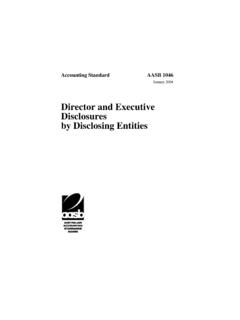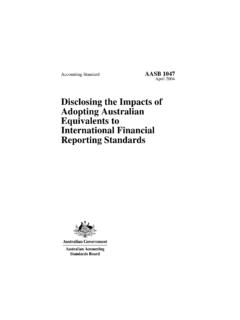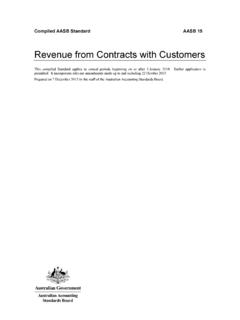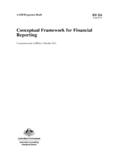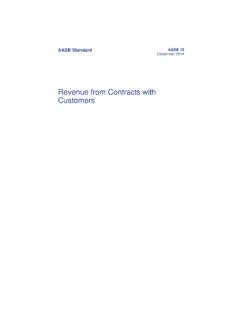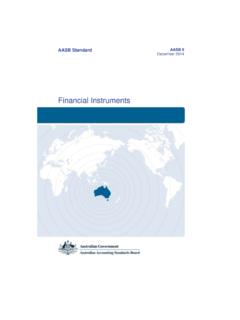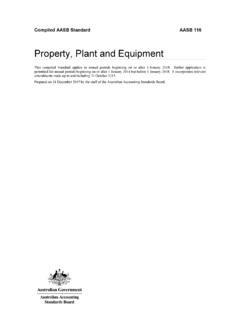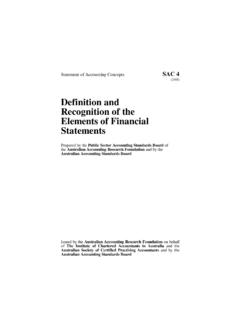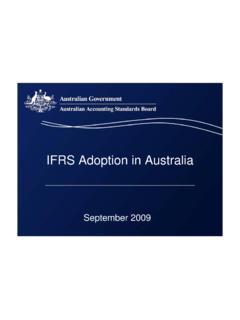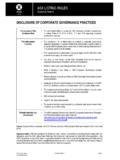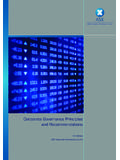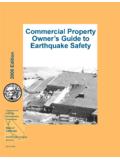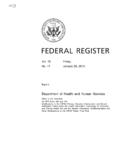Transcription of Consultation Paper Conceptual Framework
1 AASB Invitation to Comment ITC 39 May 2018 Consultation Paper Applying the IASB s Revised Conceptual Framework and Solving the Reporting Entity and Special Purpose Financial Statement Problems Comments to the AASB by: 9 August 2018 for Phase 1: Short-term approach; and 9 November 2018 for Phase 2: Medium-term approach (refer to inside cover) ITC 39 2 COPYRIGHT How to Comment on this AASB Invitation to Comment Comments on Phase 1: short-term approach and Appendix A of this Consultation Paper are requested by 9 August 2018. Comments on Phase 2: medium-term approach of this Consultation Paper are requested by 9 November 2018. Formal Submissions Submissions should be lodged online via the Work in Progress Open for Comment page of the AASB website ( ) as a PDF document and, if possible, a Word document (for internal use only).
2 Other Feedback Other feedback is welcomed and may be provided via the following methods: E-mail: Phone: (03) 9617 7600 All submissions on possible, proposed or existing financial reporting requirements, or on the standard-setting process, will be placed on the public record unless the Chair of the AASB agrees to submissions being treated as confidential. The latter will occur only if the public interest warrants such treatment. COPYRIGHT Commonwealth of Australia 2018 This work is copyright. Apart from any use as permitted under the Copyright Act 1968, no part may be reproduced by any process without prior written permission. Requests and enquiries concerning reproduction and rights should be addressed to The National Director, Australian Accounting Standards Board, PO Box 204, Collins Street West, Victoria 8007.
3 ITC 39 3 CONTENTS Contents Consultation Paper APPLYING THE IASB S REVISED Conceptual Framework AND SOLVING THE REPORTING ENTITY AND SPECIAL PURPOSE FINANCIAL STATEMENT PROBLEMS page executive SUMMARY 5 Two problems tackled within this Consultation Paper 5 Options considered to solve the above problems 6 The AASB s preferred option Option 1: Two-phased approach to applying the IASB s RCF 6 Other important considerations 9 Project timeline 9 Current requirements not impacted by proposals in this Consultation Paper 9 MATTERS FOR COMMENT 10 Specific matters for comment on Phase 1 due 9 August 2018 10 General matters for comment on Phase 1 due 9 August 2018 10 Specific matters for comment on Phase 2 due 9 November 2018 11 General matters for comment on Phase 2 due 9 November 2018 11 Section 1: What are the problems we are trying to solve and why is our action needed?
4 12 Background 12 What objective are we trying to achieve? 12 The first problem applying the RCF and addressing the reporting entity definition clash 12 The second problem SPFS 14 The bigger problem improving the Australian Financial Reporting Framework 15 Why is our action needed? 15 SECTION 2: OPTIONS CONSIDERED 17 Five options considered 17 Option 1: Two-phased approach to applying the IASB s RCF 17 Option 2: Operate with two Conceptual frameworks 22 Option 3: All entities to apply the RCF when it first becomes applicable 23 Option 4: Do nothing and lose IFRS compliance 26 Option 5: All entities to apply the RCF, change the name of the Australian reporting entity concept and prescribe minimum requirements for SPFS 27 SECTION 3: WHO WILL THE AASB CONSULT AND HOW?
5 30 Who will the AASB consult and how? 30 Project timeline 30 SECTION 4: WHAT IS THE AASB S PREFERRED OPTION AND HOW WILL THE AASB EVALUATE ITS PREFERRED OPTION? 31 The preferred option Option 1: Two-phased approach to applying the RCF 31 How will the AASB evaluate its option? 32 ITC 39 4 CONTENTS page SECTION 5: DETAILS OF THE AASB S PREFERRED OPTION, INCLUDING TIER 2 ALTERNATIVES, NEXT STEPS AND MATTERS FOR COMMENT 33 Details of Phase 1: Short-term approach maintain IFRS compliance and operate with two Conceptual frameworks 33 What happens next in respect to Phase 1? 33 We need your feedback on Phase 1 34 Specific matters for comment on Phase 1 34 General matters for comment on Phase 1 34 Details of Phase 2: Medium-term approach to apply the RCF to all entities 35 What would the revised Framework look like after implementation of Option 1?
6 40 What happens next with respect to Phase 2? 41 We need your feedback on Phase 2 41 Specific matters for comment on Phase 2 41 General matters for comment on Phase 2 42 APPENDIX A Proposed amendments to pronouncements resulting from Phase 1 43 APPENDIX B Illustrative amendments to pronouncements resulting from Phase 2 50 APPENDIX C Detailed analysis of issues with incorporating the IASB s RCF in Australia 57 APPENDIX D Conceptual Framework for Financial Reporting (IASB) Chapter 3 Financial Statements and the Reporting Entity 68 ITC 39 5 executive SUMMARY executive summary 1 The International Accounting Standards Board (IASB) issued a revised Conceptual Framework titled Conceptual Framework for Financial Reporting (referred to throughout this Consultation Paper as RCF ) in March 2018.
7 2 The Conceptual Framework describes the objective and concepts for general purpose financial reporting under International Financial Reporting Standards (IFRS). Its purpose is to assist standard-setters develop Standards that are based on consistent concepts, and to help preparers develop consistent accounting policies when no Standard applies to a particular transaction or event, or when a Standard allows a choice of accounting policy. It also assists anyone looking to understand and interpret the Standards. 3 Making the IASB s RCF applicable in Australia is essential as in accordance with the AASB s strategy1 and Financial Reporting Council directive: (a) publicly accountable for-profit entities and other entities voluntarily reporting compliance with IFRS must be able to maintain compliance with International Financial Reporting Standards (IFRS); and (b) IFRS is used as a base for determining the reporting requirements for all other entities, modified as appropriate, in accordance with The AASB s Standard-Setting Frameworks for For-Profit and Not-for-Profit Entities2.
8 4 In order to apply the RCF in Australia, the AASB has to address a reporting entity definition clash as outlined below. This first problem is unique to Australia and highlights the importance of solving the second more significant financial reporting problem. There is currently a lack of comparability, trust and transparency, resulting from entities self-assessing that they can prepare special purpose financial statements (SPFS)). Two problems tackled within this Consultation Paper The first problem resolving the reporting entity definition clash 5 The reporting entity concept (referred to throughout this document as the Australian reporting entity concept ) in Statement of Accounting Concepts SAC 1 Definition of the Reporting Entity and some of the Australian Accounting Standards (AAS) is defined and used differently compared to the RCF3.
9 Therefore, applying the RCF without modification in Australia would remove the Australian reporting entity definition so that the IASB s definition of RCF could be applied throughout AAS. Removing SAC 1 and the Australian reporting entity concept would remove the ability for entities to prepare SPFS. Refer to Section 1 paragraphs 33-43 and Appendix C paragraphs 1-17 for more information on the first problem. The second problem SPFS 6 Australia is the only country to have a concept that effectively permits entities to self-assess what type of financial reporting is required when legislation or otherwise (ie such as a constitutional document) requires the preparation of financial statements in accordance with accounting standards.
10 Unlike other countries, in Australia, two similar entities can prepare very different sets of financial reports, one preparing general purpose financial statements (GPFS) using a robust and consistent Framework and the other SPFS, with self-selected requirements. This reduces comparability for entities of similar economic circumstances and undermines the fundamentals of trust and transparency. 7 Previous research by the AASB4 indicates that many entities (approximately 55-60%) publicly lodge SPFS in Australia, suggesting a strong need to find a solution to improve the consistency, comparability, usefulness and credibility of financial reporting in Australia. 8 This second problem must be resolved by the AASB as legislatively the AASB must ensure that there are appropriate accounting standards for each type of entity that must comply with accounting standards (ASIC Act S229(2)(c)) and facilitate comparability (S224).
